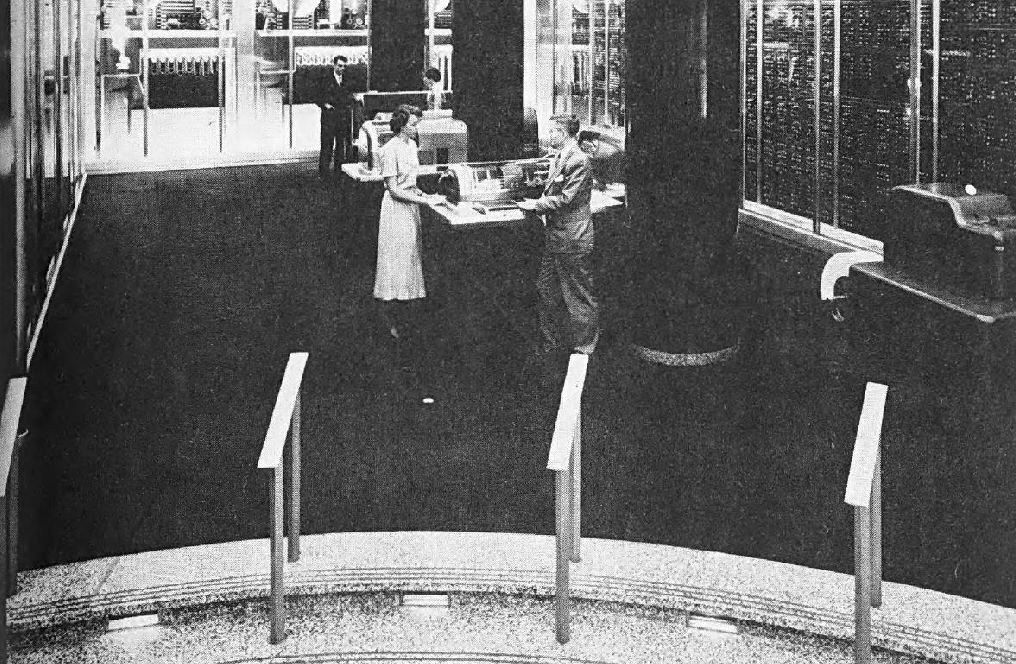
The IBM Selective Sequence Electronic Calculator (SSEC), presented to the public on January 27, 1948, was conceived of as a successor to the Harvard Mark I.
The story behind it was that Thomas J. Watson, Sr. was miffed that Howard Aiken failed to give appropriate credit to IBM for its funding of the Harvard Mark I at its dedication ceremony, and thus wanted to upstage it.
While the Harvard Mark I was built entirely from relays, the SSEC used vacuum tubes to perform its arithmetical calculations. They were the most time-consuming portion of each step of a program, and so the SSEC was much faster than the Harvard Mark I, but because other parts of the SSEC were still electromechanical, going from one program step to the next took place at electromechanical sppeds. So it was much slower than a fully-electronic computer would have been. In this, it is an illustration of what would later become known as Amdahl's Law; just as the strength of a chain is determined by its weakest link, the speed of a computer is constrained by its slowest part.
While the importance of the SSEC as a technical milestone may therefore be limited, in another respect, it was very important indeed.
Located on the ground floor of IBM's World Headquarters in downtown New York City, behind large windows, it was an impressive sight to passers-by on the busy sidewalks which adjoined the building. This, and the publicity surrounding this computer, and its purpose: to assist the scientists of the nation and the world in their work, forcibly brought the fact that electronic automatic calculating machines existed, and were revolutionary in character, to the people of the United States and the world.

The picture shown above is a detail from an IBM photograph of the SSEC as it appeared on the cover of Naval Research Reviews. Many better pictures of this computer are, of course, available online, but hopefully this will give some idea of how it looked.
Here is a clearer and more complete image:
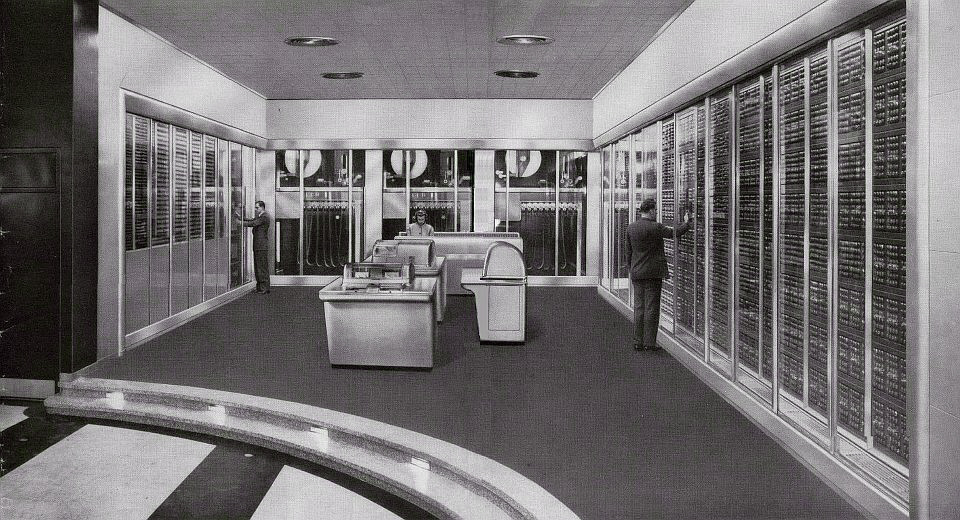
This is the infamous photo of the SSEC which had the pillars, which could not be removed as J. Watson Sr., requested, because they were needed to hold the building in which it was housed up, retouched away. Because the source I felt I could use for this photo had some of it lost in the gutter, I've also retouched this image as well.
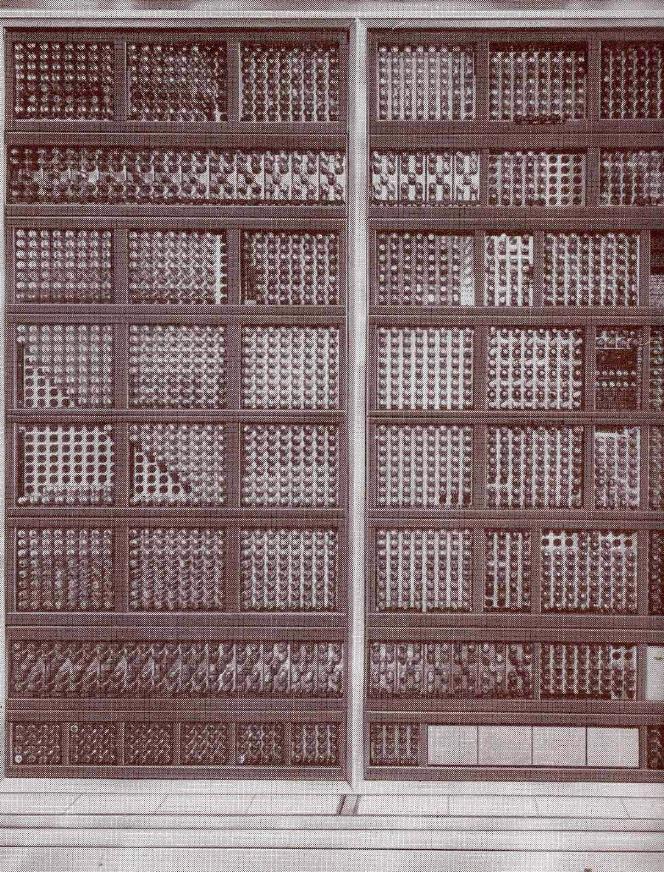
Additionally, at right is reproduced a photo from the same source, an IBM brochure provided to the press at the annoouncement of the machine, of some of the racks of tubes which the computer used to perform its calculations.
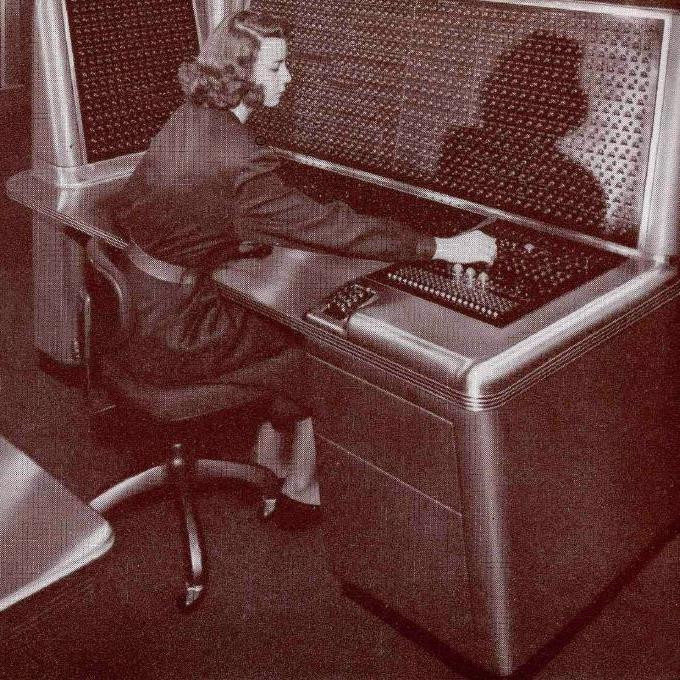
At left is a photograph of the control console of the SSEC, with an operator present. It appears to be a detail from the photograph which appears in full color on the cover of Radio Craft magazine, as shown below.
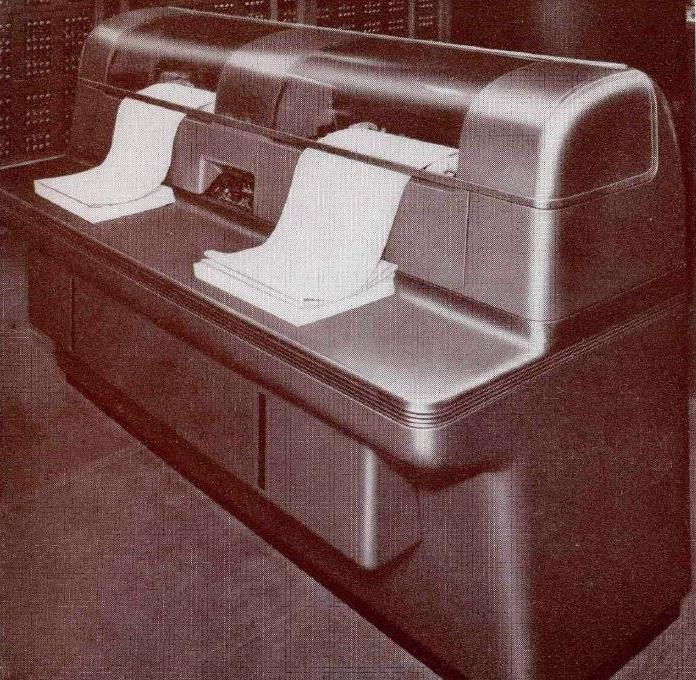
Given that the SSEC would be dedicated to science, and served as a prestige project for IBM, it spared no effort in making the components of the system attractive in appearance, compared to IBM tabulating equipment performing similar functions. Hence, I've decided to include still more images of this historic machine. At right is the system's line printer.
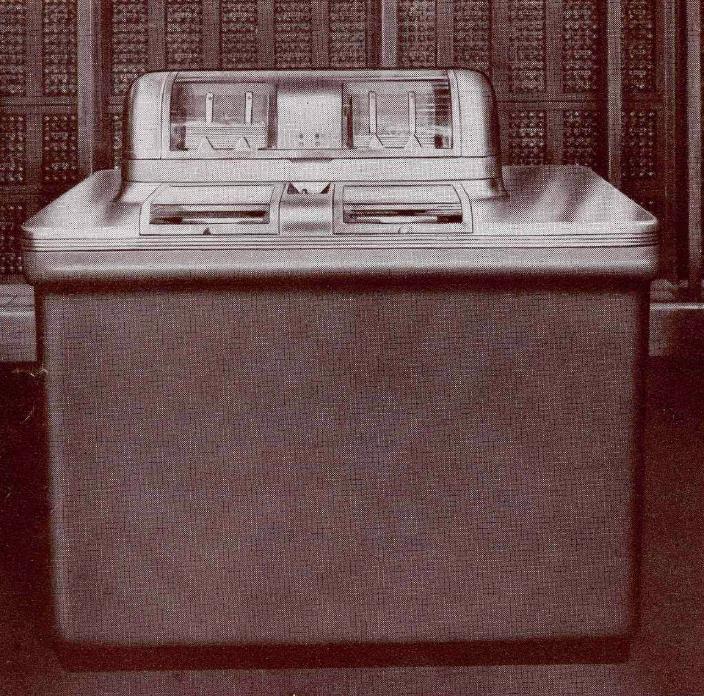
And at left is the card reader used with the SSEC.
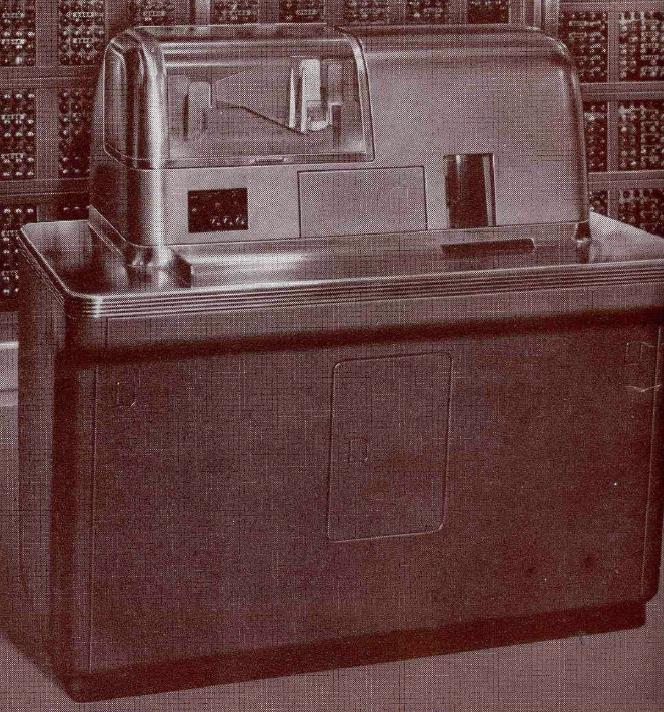
And at right is the card punch it also used. Note that some of the tubes of the SSEC itself are visible in the background.
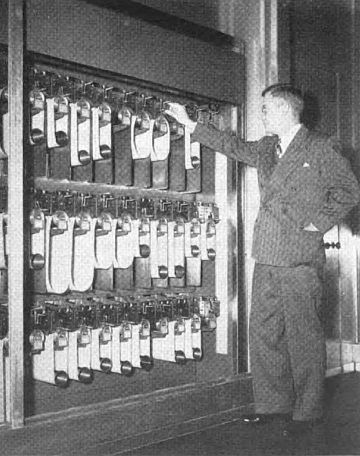
And at left, from a different source, is an image of the tape loops which are on the left side of the machine, used for subroutines and tables.
It performed calculations electronically on vacuum tubes, but program steps were executed as they were read from special paper tapes.
The paper tapes were the width of 80-column punch cards, and had the same sort of rectangular holes punched in them: however, as the tapes had round sprocket holes on their edges, they were 78-channel tapes.
Numbers used in calculations were retained in three types of storage; the smallest and fastest consisted of vacuum-tube flip-flops; there was also intermediate storage made up of electromechanical relays; and, finally, the same kind of paper tapes used for program steps could also be punched with numbers, and then read back in at several reading stations following the punching station.
Although it was not concieved of, or intended, as a stored-program computer, theoretically program steps could be obtained from the faster forms of storage as well, which has led some to propose that the SSEC rather than the Manchester prototype should be considered the first stored-program computer. It might be asked how this could be possible, since if the SSEC was not designed as a stored-program computer, obviously, it would not have a program counter. However, the instructions of the SSEC each contained the address from which to fetch the next instruction; this was done to facilitate switching to another paper tape reader in order to execute a subroutine, rather than for the reasons this was done on computers with drum memories, but it allowed a program to be put in consecutive locations in fast memory as well. While putting a handful of instructions in the vacuum-tube registers would not be of much practical value, as noted above, there was also intermediate storage of a larger capacity made from relays, and one could easily imagine putting a small subroutine there to speed up a program. So the idea of it being the first stored-program computer may not be quite as far-fetched as it seemed to me when I first heard of this claim, even if its potential to be used this way may never have been utilized for all that is known.
Before getting too optimistic, however, it should be noted that the fields indicating where the next instruction is to come from are only two digits long, rather than three digits long, as would be required to be able to access any location in memory. (Operand addresses are five digits long, in order that while a three-digit address is used for everything else, only a single-digit address field is used instead when one of the eight electronic storage registers is used; this, presumably, is to speed decoding for them, to increase their advantage.) However, it is explicitly noted in the SSEC patent that placing instructions in relay storage and modifying them there is the way in which the machine performs conditional branching, which confirms that it is indeed a stored-program computer.
In fact, since each instruction for the SSEC was stored as a pair of 19-digit numbers, the first half of each instruction had a pointer to the first half of the next instruction, and the second half of each instruction had a pointer to the second half of the next instruction, which is unusual and perhaps unique.
Also, as I have noted elsewhere on my site, selecting one of the 150 locations in relay memory to read is done by relays, so placing a program in relay storage was not a way to attain fully electronic speed.
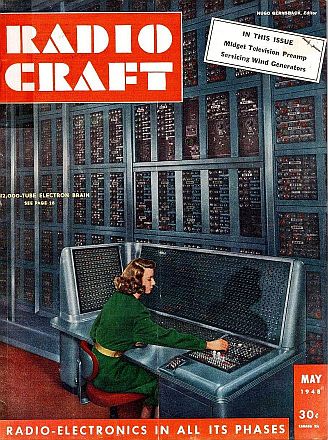
The SSEC was dedicated to promoting the advance of science. It recieved a considerable amount of publicity in its day, and has been said to have "captured the imagination" of the public. What that meant in practice is that the publicity surrounding the SSEC gave rise to a significantly greater level of public awareness than either the Harvard Mark I or the ENIAC (never mind the Bell Labs relay computer!) that powerful electronic calculating machines existed. Its components, including a console, a dual line printer, and a card reader-punch, were given a gracefully curved design; the wall containing its 12,000 vacuum tubes behind glass panels gave it an imposing appearance. The SSEC itself appeared on the cover of the May, 1948 issue of Electronics magazine (strangely enough, that was the issue following the one, the April, 1948 issue, which had an article about the SSEC) and also on the cover of the May, 1948 issue of Radio Craft, which later became Popular Electronics (this time, the article about it was in the same issue), and which is shown on the right, but its appearance inspired drawings or paintings of the computer of the future that appeared on the covers of the New Yorker and Astounding Science Fiction, although the latter cover, appearing on the October 1957 issue, also seems to have drawn inspiration from some later machines as well, as the painting includes units resembling the Williams tubes of the IBM 701 computer.
Also, it appeared on screen in the 1952 motion picture Walk East on Beacon, which was based on a book by J. Edgar Hoover about the Soviet theft of the secret of the atomic bomb from the United States.
The first problem which it handled was to calculate the position of the Moon for an ephemeris that ran from 1952 through 1959. Incidentally, this means that it is not the case, as occasionally claimed, that its calculations were used in the Apollo missions, as they ran out ten years too soon.
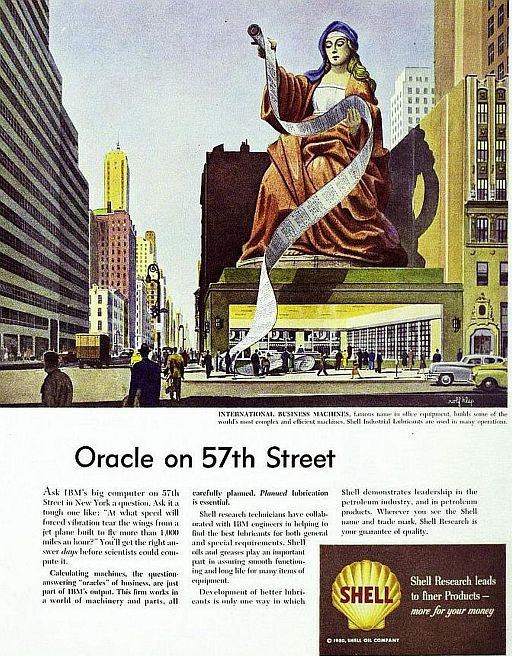
I remember an advertisement by a computer company which said that their consultants would recommend a competitor's equipment if it was a better fit to your problem. That would, of course, have a tendency to attract many people to try them first.
This was reminiscent of a scene in a famous heartwarming Christmas movie, Miracle on 34th Street, where a newly-hired department store Santa advises parents on where they can find the toys they're looking for, even at competitors of that department store... and he ends up not being fired, because that increased business for the store.
A popular line of database software is known by the name Oracle, and Borland gave their Pascal compiler the name Delphi. While it is generally agreed that the famous Oracle of Delphi was but a sham, the hype surrounding it was so successful that it lives on in our consciousness to the presnt day.
The SSEC began life providing services free of charge to academics in scientific research, but before it was removed from its original location in August 1952, it eventually became available for paid work for commercial customers.
One such customer was Shell Oil. And, late in 1950, they ran an advertisement which noted that they had improved the quality of their gasoline by availing themselves of the services of the SSEC.
The advertisement bore the heading "Oracle on 57th Street", and has been used as an example to illustrate the awe in which the computer was held at its inception. Since both IBM's head office and Macy's Department Store were located in New York City, perhaps I'm seeing an influence from the movie that is more apparent than real.
I have recently learned that after the SSEC was removed from IBM's midtown Manhattan location, it was loaned to Harvard University. A photograph of it being worked on at that location, credited to International News Photos, appears in "The New Wonder Book: Cyclopedia of World Knowledge" from 1954. This part of the story of the SSEC, which is somewhat surprising, as the SSEC was originally constructed at least partly out of pique with Harvard's Howard Aiken, with the intent of outshining the Harvard Mark I. This appears to be a little-known part of the story of the SSEC.
Aiken worked on successors to the Mark I at Harvard. The Harvard Mark IV, completed in 1952, was fully electronic; it had a small core memory in addition to drum memory, and was made for the U.S. Air Force.